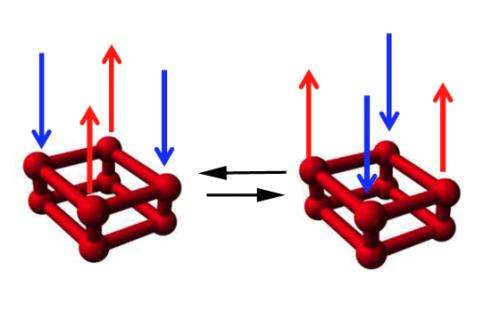The quantum dance of oxygen

Under extremely high pressure conditions oxygen molecules group into quartets and give rise to a 'dance of their magnetic moments.' This, as observed in a new study carried out by SISSA in collaboration with ICTP and published in PNAS, results in magnetic properties never previously observed in these conditions and in theory points to the existence of a new phase of the element, called epsilon 1.
Perhaps not everyone knows that oxygen has – quite unusually for such a simple molecule – magnetic properties. The phase diagram of solid oxygen at low temperatures and high pressures shows, however, several irregularities (for example, proper "information gaps" with regard to these magnetic properties) that are still poorly understood. A team of researchers from the International School for Advanced Studies (SISSA) and International Centre for Theoretical Physics Abdus Salam (ICTP) of Trieste, while trying to understand the origin of these phenomena, have identified a new phase, in which oxygen exhibits previously unknown characteristics.
The magnetism of oxygen is related to the spin of its electrons. "In each molecule two electrons align their intrinsic spin and magnetic moment, spin 1/2, giving rise to a spin 1 magnetic moment", explains Erio Tosatti, professor at SISSA and among the authors of the paper just published in PNAS. "At very high pressures, however, the world goes upside down", he jokes, "insulators become superconductors, magnetic materials lose their properties and so on. Like oxygen, for example: while exhibiting magnetic properties at intermediate pressures, oxygen molecules lose their magnetism at pressures above 80,000 atmospheres. Or at least that's what we used to think, because our studies suggest that the situation is more complex than that".
The first non-magnetic phase, called epsilon, has been studied for years. "Scientists didn't understand what was going on", continues Tosatti. "A few years ago, it became clear, first experimentally and then theoretically, that this loss of magnetism is caused by the sudden grouping of molecules into 'quartets', in turn related to some sort of 'reluctance' of oxygen to become metallic". At even higher pressures (one million atmospheres) oxygen takes on a metallic form and becomes a superconductor. "The formation of quartets with loss of magnetism could be defined as a gimmick used by oxygen to delay becoming metallic. An interesting explanation, but some inconsistencies in the epsilon-phase data at 'lower' pressures, just above 80,000 atmospheres, prompted our group to delve deeper into the matter", explains Tosatti. Tosatti, together with Michele Fabrizio from SISSA, Yanier Crespo from ICTP and Sandro Scandolo, also from ICTP, performed very delicate and extensive calculations and developed quantum models specifically to understand this corner of the phase diagram".
More in detail...
"Our study demonstrated that the epsilon phase is actually divided into two phases and that in the first, from 80,000 to 200,000 atmospheres, which we called epsilon 1, the quartet molecules engage in a real 'quantum dance'".
The four scientists observed, in fact, that the four oxygen molecules in each group constantly exchanged magnetic moments. "It's as if the molecules were playing ball with their spins, the direction in which the electrons rotate around their axis, continuously passing the ball to one another, so that the mean value of each molecule's moment and magnetism is zero. In the epsilon 1 phase of oxygen, the molecules retain their spins, but these fluctuate coherently within and across quartets like a chorus of cicadas", explains Tosatti.
Based on these observations, it isn't true that oxygen in epsilon 1 phase has no magnetic properties, it's just that they hadn't been calculated or measured clearly. "Following our results we checked the literature on the subject and found experimental findings consistent with our model, but which had so far been regarded as anomalies" specifies Tosatti.
This study therefore divided the epsilon phase into two, epsilon 1 (from 80,000 to 200,000 atmospheres), with fluctuating magnetic properties, and epsilon 0 (from 200,000 to 1,000,000 atmospheres), without magnetic properties. "We considered a new transition line between the two phases, perhaps with a critical point, which would be unprecedented in this context. There are also other implications, for example as regards the magnetic response and dissipation present in epsilon 1 but not in epsilon 0", explains Tosatti. "Now we hope to prompt the experimental physicists to verify all these new data".
More information: Collective spin 1 singlet phase in high-pressure oxygen, PNAS, www.pnas.org/cgi/doi/10.1073/pnas.1404590111
Journal information: Proceedings of the National Academy of Sciences
Provided by International School of Advanced Studies (SISSA)





















